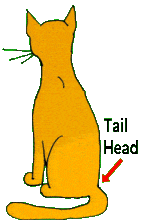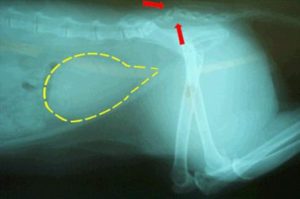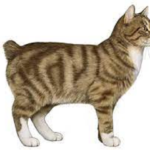First, an Anatomy Lesson
Tails are expressive body parts used by cats to convey things like annoyance, fear and

confidence. Tails are also used for balance. The tail consists of the caudal vertebrae along with muscle, ligaments and tendon to hold it all together. The tail attaches to the body at an area called the tail head. The first caudal vertebra attaches to a backbone called the sacrum, which is the part of the pelvis that connects the tail and further toward the head connects to the back (lumbar) vertebrae.
The spinal cord itself does not extend down this far, but nerves coming from the spine run through the tail. So, injuries to the tail can still cause serious nerve damage.
This nerve damage close to the tail base or the head of the tail can help tell us what your cat can’t – when they’ve had part of their pelvis injured at the sacrum.
What Might be Noticeable at Home
Cats with broken tails at the sarcum might show any of these symptoms:
- A tail that drags or is never held high.
- Involuntary dribbling of urine.
- A dilated, flaccid anal sphincter with or without diarrhea or fecal incontinence.
- Incoordination of the rear legs.
Any of these symptoms might lead the cat into the vet’s office for an evaluation. Some additional findings the veterinarian might notice include:
- A distended bladder that is relatively easy to express manually (in other words, the bladder is full but can be emptied with careful squeezing.)
- Bloody urine (if the tail trauma is recent).
- Painful tail head.
- Loss of sensation in the tail.
A radiograph will often show a break in the tail or a dislocation, although in some cases the

tail bones are intact. How permanent the limp tail and bladder signs are depends on whether the nerves have been over-stretched or actually torn.
Classification of the Injury
In a 1985 study by Smeak and Olmstead, sacrocaudal fractures in cats were divided into five groups.
Group one: Cats with Painful Tail Heads as their only Sign
These individuals are minimally affected and, while they may or may not have a chronically sensitive tail head, they are expected to otherwise have a full recovery.
Group two: Cats with Lack of Tail Mobility and Sensation as their only Sign
These cats are expected to recover tail function completely and have an excellent prognosis.
Group three: Cats with Lack of Tail Mobility and Sensation plus Urine Retention as their only Signs
Most cats will have a complete recovery.
Group four: Cats with Lack of Tail Mobility and Sensation and Diminished Anal Tone
This group of cats has about a 75% recovery rate, meaning 75% of the cats that fit this description should recover.
Group five: Cats with Lack of Tail Mobility and Sensation plus a Dilated/Flaccid Anus (i.e., Zero Anal Tone)
This group of cats has about a 50% recovery rate, meaning about half of the cats with this description will eventually recover.
A study published in 2009 showed an excellent predictor of bladder function return when pain can be detected at the tail head. In the 21 cats with sacrocaudal fracture/dislocation, all 11 cats that had pain sensation at the tail head on the first day after the injury had regained bladder function within 3 days. Absence of pain sensation in this area on the first day did not necessarily mean that bladder control would not return; 60% of cats without tail head sensation on the first day had recovered bladder control by 30 days after the injury.
Recovery Time
Nerves heal notoriously slowly. It has been said that a good six months must pass before one can say the maximum recovery has occurred and no more positive progress can be expected. Most cats who are going to recover function do so in a one-week period, and most cats who do not recover urinary control after a month probably will remain incontinent. Tail function and sensation tends to take longer.
Pet Hospital in Houston Heights
Urban Animal Veterinary Hospital
1327 Yale St
Houston, TX 77008
(713) 863-008


